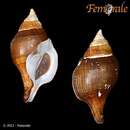en
names in breadcrumbs


Turbinella laevigata ist der Name einer Schnecke aus der Familie der Turbinellidae (Gattung Turbinella), die an der Atlantikküste Brasiliens verbreitet ist.
Das große, bei ausgewachsenen Schnecken bis zu 20 cm lange Schneckenhaus von Turbinella laevigata weist 7 bis 8 rundliche Umgänge auf, die spiralig nur sehr flach skulpturiert sind und von denen die ersten beiden Umgänge den zitzenförmigen Protoconch bilden. Der Körperumgang nimmt etwa zwei Drittel der gesamten Schale ein. Die Gehäusemündung ist eher klein und länglich und hat eine scharfkantige äußere Lippe. Die weiße Oberfläche der Schale ist mit einem recht dicken braunen Periostracum überzogen.[1]
Turbinella laevigata ist endemisch im westlichen Atlantischen Ozean an der Küste Brasiliens zwischen Amapá und Espírito Santo. Sie lebt in seichten Gewässern in der Gezeitenzone und bis 40 m Tiefe, wurde aber vor Amapá bis in 60 m Tiefe gefunden.[1][2]
Wie andere Neuschnecken ist Turbinella laevigata getrenntgeschlechtlich. Das Männchen begattet das Weibchen mit seinem Penis. Das Weibchen legt etwa 51 bis 74 mm lange und 38 bis 45 mm breite Gelege (Ootheken), die aus rund 13 bis 18 scheibenförmigen Eikapseln mit einer konvexen und einer konkaven Seite und einem Durchmesser von 16 bis 40 mm und einer Dicke von 0,2 bis 0,6 mm bestehen. Die Kapseln sitzen auf einer gemeinsamen basalen Membran, die über einen festen Stiel an einem festen Substrat wie etwa der Rotalge Bryothamnion seaforthii befestigt wird. Jede Kapsel enthält etwa 240 Eier, die sich innerhalb der Eikapsel zu fertigen Schnecken entwickeln. Jungtiere vor dem Schlupf wiesen 5 bis 8 mm lange Juvenilschalen mit drei kompletten Umgängen auf.[2]
Für Turbinella laevigata gibt es keine Veröffentlichungen über die Ernährung. Andere Arten der Gattung Turbinella wie auch anderer Gattungen in der Familie Turbinellidae fressen – teilweise ausschließlich – Vielborster und Spritzwürmer.
Turbinella laevigata ist der Name einer Schnecke aus der Familie der Turbinellidae (Gattung Turbinella), die an der Atlantikküste Brasiliens verbreitet ist.
Turbinella laevigata, common name the Brazilian chank, is a species of very large sea snail with a gill and an operculum, a marine gastropod mollusk in the subfamily Turbinellinae of the family Turbinellidae.[2]
There are two subspecies of this species:
The shell of this species is thick and heavy, and can grow as large as 200 mm in length.[3]
This species is found in Brazil.
The spawn of Turbinella laevigata has 240 eggs in every capsule; each capsule contains a high number of nurse eggs.[4]
Turbinella laevigata is used as a zootherapeutical product. It is used as a treatment for sexual impotence in traditional Brazilian medicine in the northeast of Brazil.[5]
Turbinella laevigata, common name the Brazilian chank, is a species of very large sea snail with a gill and an operculum, a marine gastropod mollusk in the subfamily Turbinellinae of the family Turbinellidae.
Turbinella laevigata is een slakkensoort uit de familie van de Turbinellidae.[1] De wetenschappelijke naam van de soort is voor het eerst geldig gepubliceerd in 1838 door Anton.
Bronnen, noten en/of referentiesTurbinella laevigata (denominada, em inglês, brazilian chank)[3] é uma espécie de molusco gastrópode marinho do oeste do oceano Atlântico, pertencente à família Turbinellidae,[2][4] originalmente classificada por Hermann Eduard Anton, em 1838.[2] Pode ser usada na alimentação.[5]
Conchas pesadas, quando desenvolvidas, de coloração branca ou creme, podendo estar encobertas por um perióstraco castanho e bastante grosso; chegando de 10 aos 20 centímetros de comprimento; com espiral moderadamente baixa, de 7 a 8 giros, e volta final globosa. Superfície encoberta por uma fina escultura de linhas espirais, lábio externo fino e arredondado, canal sifonal destacado e columela dotada de 3 pregas visíveis. Possuem opérculo córneo e protoconcha mamilar.[3][6][7][8]
Espécimes de T. laevigata provenientes da Bahia; com seu perióstraco castanho preservado (Museu de História Natural de Leiden).
É encontrada em águas da zona nerítica até os 60 metros de profundidade.[5] Os animais da família Turbinellidae são predadores.[9]
Turbinella laevigata é uma espécie endêmica do Brasil, indo desde o Piauí[7] até o Espírito Santo.[5]
T. laevigata possui duas subespécies:[2]
|acessodata= requer |url= (ajuda) |acessodata= requer |url= (ajuda) |acessodata= requer |url= (ajuda) |acessodata= requer |url= (ajuda) Turbinella laevigata (denominada, em inglês, brazilian chank) é uma espécie de molusco gastrópode marinho do oeste do oceano Atlântico, pertencente à família Turbinellidae, originalmente classificada por Hermann Eduard Anton, em 1838. Pode ser usada na alimentação.